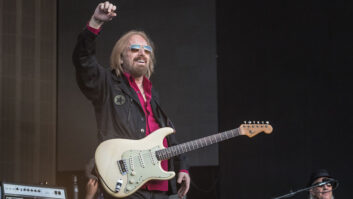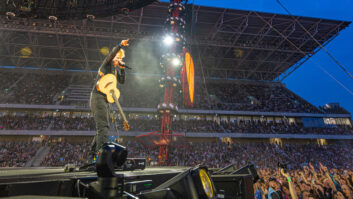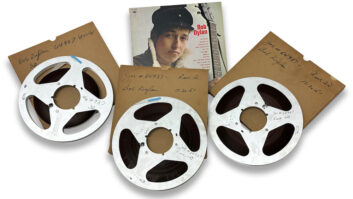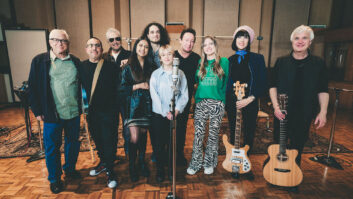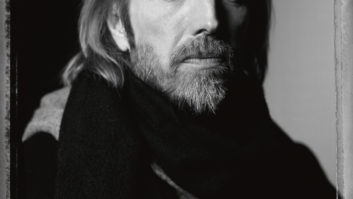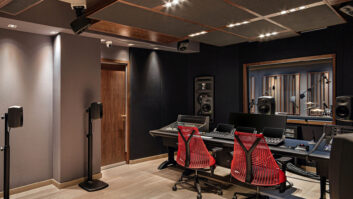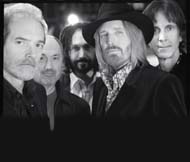
From left: Benmont Tench, Randall Marsh, Mike Campbell, Tom Petty and Tom Leadon
Photo by Martyn Atkins
On April 29, Reprise Records released the self-titled debut album from Mudcrutch, a country-rock band that originally formed in the early ’70s in Gainesville, Fla. comprising Tom Petty (bass), Benmont Tench (keyboards), Randall Marsh (drums) and guitarists Tom Leadon and Mike Campbell. Having succeeded in Florida, Mudcrutch relocated to Los Angeles in search of a record deal and national recognition, but disbanded in 1975, giving rise to the formation of Tom Petty and The Heartbreakers, with a nucleus of Petty, Campbell and Tench joined by bassist Ron Blair and drummer Stan Lynch.
In August 2007, Petty was inspired to reunite Mudcrutch at his Los Angeles rehearsal space, The Clubhouse, for informal jam sessions that quickly evolved into recording sessions when Petty and Campbell found that the band’s chemistry was working. Because the band felt at ease and played well in The Clubhouse, they decided to remain there in their rehearsal configuration to play live and record an album’s worth of songs—a mix of covers and new songs written by Petty during the sessions—instead of booking a studio.
Veteran engineer Ryan Ulyate, who has worked with Petty since Petty’s 2006 release Highway Companion, was asked to record, mix and co-produce the Mudcrutch project along with Petty and Campbell. Ulyate faced a logistical challenge in setting up the tracking sessions in The Clubhouse, where the band’s setup mimicked The Heartbreakers’ 2006 touring setup, employing wedges and a Digidesign VENUE board. Ulyate brought in his Pro Tools recording rig and consulted with Digidesign’s Robert Scovill—Petty’s longtime front-of-house engineer—on integrating the live and recording setups, and devising the final signal chain. The stage mics served as the recording mics, while Ulyate added a few more Neumann mics and recorded the band live without headphones.
Following the April 29 Mudcrutch CD release, Reprise Records plans to release Mudcrutch on vinyl and on an “audiophile” quality CD—derived from the same uncompressed stereo masters as the vinyl pressing—sometime during the summer.
I spoke by phone with Ulyate about the unique but rewarding challenges presented by this project.
It’s interesting that Tom Petty decided to reunite Mudcrutch and record an album with the band.
I think what happened was, one of the things we worked on last year was the Running Down a Dream documentary [see Blair Jackson’s “DVD Watch” review], and Tom had been working on that for, I think, a couple of years with [director] Peter Bogdanovich, and I actually went back and remixed a bunch of material for the DVD documentary. And I think in the course of doing the interviews, he started thinking about it and just said, “Hey! Why not get these guys back together?” And I’m sure glad he did because it was just great.
The album was recorded in 10 days—all 14 songs. What determined that schedule?
I think it was more an idea of, let’s start playing again and see what happens. I got the call from Mike Campbell that they wanted to do this, and he said, “Well, we’re thinking of just recording it in The Clubhouse, and not doing it in the studio.” I figured, okay, they want to do a real rehearsal—not really a recording session with headphones, but a band rehearsal where they’ve got wedges and [they’re] in the same room, as if they were rehearsing for a tour or something. I think that was part of the design of doing it there, just finding a place where everybody felt comfortable and they had the time to hang out, tell stories and reconnect after all these years.
We rigged up this system where we had one of those Digidesign VENUE boards as a monitor board, and then all the audio was actually passing from the stage racks through a Pro Tools rig, half of which was going to my Pro Tools D-Command board—I set up a little control room in a room off to the side—and then the rest of it just passed through to the monitor mixer. Basically he was mixing monitors and at the same time I was in another room mixing what I thought would sound like a record.
We were monitoring it as we were going. Every so often I’d solo something just to make sure that there wasn’t too much of something else in it. Everyone kept the levels pretty reasonable, so we didn’t have a problem with it. It’s not complete isolation, but if you’re going for a complete take, then you don’t have to worry that much about isolation, because it’s not like, “Oh, gee, that drum is going to bleed into something when we get rid of it.” But we’re not getting rid of it, so it’s okay.
It worked so well [that] the first day, they came in and we cut three songs, and those three songs are on the album. And that night I made them rough mixes, and they were listening to those songs on the way into rehearsal the second day.
It was a very cool way of working, because it got the band out of the mode of thinking that they were in the studio. So because of that, they ended up recording a live album—a live-in-the-rehearsal-room album. And I think that’s what made it such a good album, because they had to make it happen there.

Sometimes that sound that comes from the wedges and all that stuff adds a little bit of excitement to the thing overall and gives it more of a feel. So, in this case it was manageable and it helped the vibe, and it made the band play as if they were playing live—they really went for it a lot more than if we were doing [studio] tracks.
The other thing that was really cool about it was they did it in their space. They were in their environment. If Tom [Petty] wanted another guitar, he’d just point to [crew chief Alan “Bugs” Weidel] and say, “Hey, give me that Rickenbacker, the 1959 up there!” I think the fact that they were in their element also made them a lot more comfortable, and also affected the final result.
How was the recording setup conceived?
Robert Scovill [of Digidesign], who was Tom’s front-of-house engineer for years until just recently, was quite instrumental. And there was another guy [from Digidesign] who helped out named Chant Peck. I gave Scovill a call and I think he came up with this diagram as to how we could interface the board and my Pro Tools rig, and accomplish all the stuff we wanted to, because it was an unusual arrangement. He really was very helpful in terms of getting this whole thing figured out, and then Chant was there on-site. They were very helpful and supportive in the first couple of days, making sure that everything was running. They did such a good job that the band came in and literally an hour after they showed up, we were tracking. That’s pretty cool.
The one thing that was kind of tricky was [that] I wasn’t in control of the levels; it was Brian Hendry, the monitor engineer, who was actually setting the level that was getting to me. So we had to talk a lot about that, just to make sure the levels got right. What I was getting was straight off the [VENUE] mic pre, digitized and flat. All the EQ’ing and compression was done completely with plug-ins. There was no EQ or compression that touched the thing in the analog world—and that’s the way I like it! [Laughs] I’d rather have it be absolutely flat, uncompressed, un-EQ’d, and then I can mess with it from there.
What kind of equipment did you bring to these sessions?
I’ve been mixing in the box for the last couple of years. I got a D-Command and a full-blown Pro Tools rig, with every plug-in known to man…not every plug-in known to man, but I guess there’s a lot of them [laughs]. I’ve got some really good speakers. I’ve got some ATC 50s with a Bag End subwoofer, and that’s basically what we were monitoring through.
What are some of the key plug-ins that you use?
The two things I use 99.9 percent of the time are the MDW [Massenburg Design Works] EQ, because I think that’s the best-sounding EQ, and the Universal Audio 1176 [TDM plug-in], which they no longer make. The one that I have still works because I’ve got a quad [core Mac] G5, which has the PowerPC chip, and it still works on that chip so that’s my go-to limiter. But the philosophy of Mudcrutch was just trying to keep it old-school—trying to keep it as real and pure as possible. So I really didn’t do a lot in terms of plug-ins. The only effects I think I used were plate reverb—it was either [Trillium Lane Labs] TL Space or [Audio Ease] Altiverb plate reverb. I think TL Space has a bright one that I use, and Altiverb has a bigger one that I might have used.
For slap I think I used the Digi delay and then maybe filtered it. And then I think I used some of the [Line 6] Echo Farm stuff on guitars in a couple of places. They have a couple of really good old Echoplex vintage guitar box [emulations]. Mostly, it was just the guitars exactly the way they sounded, but in a couple of places I might have added some of that. [On] one of the solos I think I added the Eventide Instant Flanger from the Eventide collection.
So, I used plug-ins, but they had to be plug-ins that emulated things that were happening in 1971 [laughs]. That was my rule, just to stay with the vibe of the band.
What kinds of guitars and amps did Mike Campbell and Tom Leadon use?
Mike Campbell actually had three amps. He’s got two Fender amps that he plays through, and one’s a little crunchier—they both have distinct tones, and it’s great because it gives me as the engineer the option to use one or the other or a combination, depending on what the material is. And he’s the kind guy who could just get a sound out of anything. I mean, I literally don’t think I EQ’d any of his guitar tracks. His sounds are so good, and all the effects. I put slap on a couple of his tracks, but 99 percent of all the effects and stuff is just him working the pedals. He also had one other guitar amp, which is in a box, and I don’t think we ever listened to it [laughs]. But I finally pushed the fader up, I listened to it, it was just completely overdriven, and there was one song called “The Wrong Thing To Do,” where I just needed something really ridiculous on the chorus, and I brought up that overdriven guitar track just for the chorus, and it was just what the doctor ordered [laughs].
[Campbell has] this really neat Telecaster—I don’t know what vintage it is, but it’s got a bender on it, where if you pull the neck down, it bends the B-string a up a whole tone, so it’s a way of getting a country sound, like a pedal-steel sound out of an electric guitar. And he used that a lot on the album—like on “Lover of the Bayou,” the intro to that, and “Queen of the Go-Go Girls.” He settled into that guitar for most of the album, and it’s cool because it kind of gave the album a certain personality.
And then Tom Leadon played a [Gibson ES-335] on a lot of stuff. I think he used a Strat on a couple of things, like the instrumental called “June Apple.” And he did a lot of the acoustic stuff, too.
I understand that Tom Petty brought in songs that were not quite finished. So, how did that go down? Did they just get that one good take out of those, or…?
Well, he’d bring stuff in and they’d work them out. In the case of “Crystal River,” which is one of the songs we cut on the first day, they just figured out. They just did this definitive version of that track, and after they were done with it, I think everyone just said. “Well, we can’t do that again. That was it.” So, in the case of that song, literally it was the first time they played it after having figured out what the chorus was, and they nailed it.
In the case of some of the other songs, they’d work it out and they’d maybe go through about three or four takes until they found one that they were happy with. I don’t think anything went beyond five takes or something like that. They didn’t labor [over] stuff. But it was really cool just to see how it would come together. I think that definitely kept the band on their toes, because these guys had to learn this stuff and figure it out, and I think it really created an air of excitement.
These songs are so fresh—they just have a vibe about them. [Petty] just knew he had a great band, and he had to go home and write some material for them every day.
How did the mixing process go?
This album was mixed at my place and at Tom Petty’s place [Shoreline Recorders], and Tom’s got the same Pro Tools setup that I have. He doesn’t have the [D-Command] board, but I made sure that his system had the same plug-ins and the same specs as mine, so when it came time to work with Tom on the mixes, I would just take the drives over to his place, plug in the drives, and we could work over there. And then if there’s something that I needed to do on my own, I could go back home and do it at my place.
And just because of that workflow kind of thing, Pro Tools is the only way to do it. It just made it so easy to do that—the ability to make any kind of change by just opening up a session. That kind of workflow just trumps anything. So, my feeling was that that’s the only way to go for this kind of thing.
What was the time frame like in the mixing stage, considering that you tracked it in 10 days?
Well, the mixing was a lot more luxurious [laughs]! We were under no deadlines; there was no pressure to get it done. We finished the album before I think Tom even played it to the label guys, so we had the luxury of being able to take our time. Mike and Tom are the other co-producers, and so we had to get it to the point where we were all really happy with it, and sometimes that meant we were working, and sometimes we took some time off.
My philosophy with this [project] was, “Engineer, do no harm.” Just try and let as much of the band come through and stay as transparent as you can.
Matt Gallagher is an assistant editor at
Mix.
PLAY: Must Play
Scare Easy
PLAY: Must Play
Orphan of the Storm
